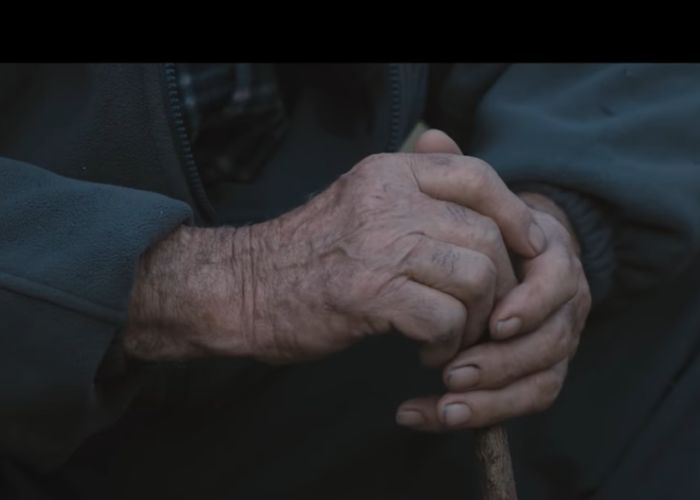PROVINCIA DE TERUEL – With the departure of 89-year-old Juan Martin Colomer, he signs the death warrant for his village. However, he does this with a lot of pain in his heart. It is not for nothing that he lived there alone with his wife without running water for almost 35 years. They were the last two.
They have had electricity via solar panels for a few years now. His wife Sinforosa is now 92 and recently broke her hip and had to move into a care home. For Juan, that means that he will live with her son in Villafranca, 20 kilometres away. However, it was not an easy task to convince the almost 90-year-old man that living alone in a place with temperatures of 10 degrees below zero with a transistor radio as the only communication with the outside world was not the best option.
Every few days since he left, he comes by car to the now deserted village to sweep the church and feed the animals. In the article that El País wrote about him, he knows exactly who has lived where in the three streets that make up the village. Dilapidated houses, a school, a square, a laundry and a church are reminders of times when it must have been lively here.
Run-out from the 1970s
Then La Estrella had a few hundred inhabitants, two bars, a priest, a teacher, an undertaker, a carpenter and eight vigilantes. Until the early 1970s, more and more residents left for the coast and the city in search of a better life. A fate that also befell so many other villages in Spain. Some went to Villafranca, others to Castellón and the bravest to Barcelona. Since then, the weeds have climbed the walls, the terraces have been neglected, the roofs have collapsed, the windows have broken and the chimneys have fallen over. In 2017, Juan and Sinforosa were the last two inhabitants of La Estrella. In the short documentary, “The Last Two” (see the video on this page), it tells their story.
Simple life
Despite the village becoming emptier, Sinforosa did not want to leave. She was born there, met her husband there and lost their 12-year-old daughter to a cerebral haemorrhage. “We are doing well and we take care of each other and our animals. We don’t take pills and we eat what we feel like,” Sinforosa said in the documentary. Every day they walked to a well for water. She did the washing by hand. They hardly used their mobile phones, because the range was only good at the top of a hill. They could read the time on the sundial in the village square.
Living off what the land could give
Their meals consisted of home-grown vegetables, eggs and honey. They were joined by more than 20 cats and a few dogs. They only packed their van to occasionally visit the nearest supermarket, their son or a doctor. The silence in the village is broken only by the sounds of the animals, the birds and twice a year by a pilgrimage.
Hard years
Juan Martín was born in 1934 on a farm nearby. At that time, the right had just won the election. “My father was shot at the end of the Civil War and my mother was in prison for seven years. Some acquaintances took care of me in a farmhouse until they returned to La Estrella years later”. It was the 1940s and decades of hunger and misery in the mountains of Teruel would follow under a harsh regime of the Guardia Civil. “They took good people who had done nothing wrong,” he says of those years.

Related: Entire village in natural park for sale with 32 houses and hotel
“I’ve worked like a mule since I could stand,” says Juan Martín “Field work is very hard and you don’t even earn a living from it. It was 12-hour days and the boss barely fed you an orange or a canned sardine. That was life here and I don’t think many young people can handle it today.”
Hunger is the hardest thing there is
“Life here is hard, but it used to be much harder. Winters have been long and cold, with snowfalls of over a metre, but the country has always given us what we need. The real hunger was what we went through after the war. Hunger is the hardest thing there is.”
The house where the couple has lived in recent years is old, and with high ceilings, and wooden doors. On the ground floor there is a fireplace, a table and a bed where the couple snuggled when the night fell and the cold came through the crept into corners.
Most sparsely populated area in Europe
With an area of 14,000 square kilometres, half the size of Belgium, and a population density of nine inhabitants per square kilometre, Teruel is one of the most sparsely populated provinces in Europe. In the past 100 years, it has grown by half and has lost its population compared to the figures for Spain, which has doubled its population.
The end of La Estrella
After all the animals have had food and the church is tidy again, Martín says goodbye to his city at sunset, which he can tell so vividly about. In his own words, he remembers better what he did 30 years ago than what he did yesterday. In any case, the couple was able to live up to what they stated in their documentary from 5 years ago: They survived thanks to their health, their sense of humour and their love for each other until their health would no longer allow it. That moment has come and with it an open end for their village La Estrella.
Related post: Buying an abandoned village is a new trend among foreign investors


